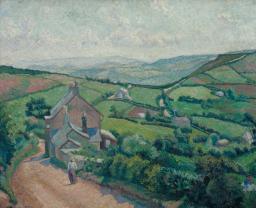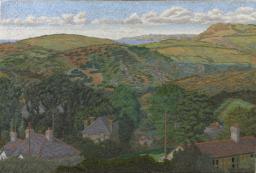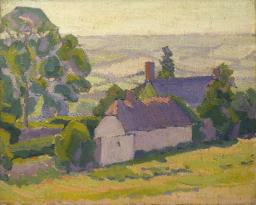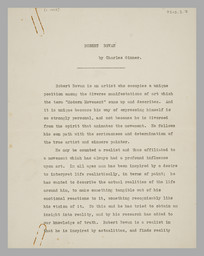Charles Ginner Porthleven 1922
Charles Ginner,
Porthleven
1922
Porthleven is a fishing village on Mount’s Bay on the south coast of Cornwall. This painting looks onto the inner harbour and its boathouse, toward the sheds of a timber yard. Bright sunshine illuminates the red and yellow façade and roof of the house to the right, with deep shadows falling on the buildings opposite.
Charles Ginner 1878–1952
Porthleven
1922
Oil paint on canvas
511 x 691 mm
Inscribed ‘C. GINNER’ in black oil paint bottom right.
Presented by the Contemporary Art Society 1924
N03838
1922
Oil paint on canvas
511 x 691 mm
Inscribed ‘C. GINNER’ in black oil paint bottom right.
Presented by the Contemporary Art Society 1924
N03838
Ownership history
Purchased from the artist by Lord Beaverbrook for £21 (20 guineas) in 1922, and presented by him to the Contemporary Art Society in 1923, by which presented to Tate Gallery 1924.
Exhibition history
1922
Charles Ginner: Recently Executed Paintings, Goupil Gallery, London, April–May 1922 (17).
1923
Paintings and Drawings, Contemporary Art Society, Grosvenor House, London, June–July 1923 (143).
1936–7
Empire Exhibition, Johannesburg Art Gallery, September 1936–January 1937 (434).
References
1952
Hubert Wellington, ‘Charles Ginner 1878–1952’, Listener, vol.57, no.1195, 24 January 1952, p.143, reproduced.
1964
Mary Chamot, Dennis Farr and Martin Butlin, Tate Gallery Catalogues: The Modern British Paintings, Drawings and Sculpture, vol.1, London 1964, p.239.
2000
Wendy Baron, Perfect Moderns: A History of the Camden Town Group, Aldershot and Vermont 2000, p.175.
Technique and condition
Porthleven is painted in artists’ oil paints on primed stretched canvas. The cloth appears to be linen; it has a plain coarse weave and retains the selvedge. The mark of the artists’ colourman P. Shea of 56 Fitzroy Street, Tottenham Court Road, is stamped in the centre of the back of the canvas. Shea also supplied canvases to Walter Sickert, Spencer Gore and J.B. Manson, although none of the artists appear to have consistently used the same supplier. The cloth has probably been sized and has been primed with a fluid white primer, probably bound in oil. The priming is continuous to the cut edges and stops just short of the selvedge. It has been evenly applied and retains the fine weave texture of the canvas. The primed canvas is attached to a wooden stretcher with zinc-coated tacks in their original positions. The dimensions of the support conform to a standard size suggesting that it was purchased pre-stretched from the colourman.
No initial drawing or means of transfer of the design from a drawing remain visible beneath the opaque paint film. A thin underpainting remains visible around the edges of some of the shadows. The ‘drawn’ elements in oil paint relate to this layer and are consistent with the remainder of the painting. There are very few alterations apparent during the process of painting. The top section of the image corresponds closely to a pen and ink drawing with watercolour dated 1923,1 with only variations in detail, suggesting that they were derived from the same initial drawing. The painting is executed in oil paint with the possible addition of some painting media which produced well-bodied colour that dried slowly retaining softened brush marks and impasto in the thicker more layered areas (see also Tate T03096). The even finish across the whole surface is in part due to the subsequent application of a varnish that gives an even gloss and saturation, and in part to the consistent handling of the dense, opaque mixtures. Each stroke remains visible even where they are merged in handling and have less texture, as in the depiction of the roofs in shadow with their close tones and lack of structural detail. Predominantly, the brush strokes are laid side by side or cleanly wet onto wet in one sitting. There are a few areas where fresh paint is applied over already touch-dry colour as on the yellow brickwork of the foreground house. Cracks, which probably began as fine contraction cracks in the surface of the slow-drying, thick paint have developed into brittle cracks in the hardened paint films. These are most visible in the lighter tints of the sunlit walls and are a familiar feature of Ginner’s work (see also Tate T03096).
Roy Perry
June 2004
Notes
How to cite
Roy Perry, 'Technique and Condition', June 2004, in David Fraser Jenkins, ‘Porthleven 1922 by Charles Ginner’, catalogue entry, May 2005, in Helena Bonett, Ysanne Holt, Jennifer Mundy (eds.), The Camden Town Group in Context, Tate Research Publication, May 2012, https://wwwEntry
Porthleven is a fishing village on Mount’s Bay near the most southerly point of Cornwall, the Lizard. The view in Ginner’s painting is of the inner harbour, looking toward the sheds of a timber yard. Ginner painted in Porthleven in 1921 and 1922. His sister, Ruby Ginner Dyer, lived at Boscastle on the north coast of Cornwall, but it is not known whether Ginner was staying with friends in Porthleven. He often worked in the West Country, and had first painted there while staying with his friend and patron, Harold Bertram Harrison, at Applehayes in Clayhidon in the Blackdown Hills in Somerset in August 1912. In September 1924 he stayed with the painter Robert Bevan at his cottage near Honiton in Devon.
The painting is a study in complex perspective, with few edges at right angles. The terms in which he thought of such design is indicated in an essay on Bevan that he wrote in 1925:
The great expanses of open country are deeply and vividly felt; the collection of farm buildings grouped compactly into a wonderful design; atmospheric luminosity conveyed without the messy blurring of one colour tone into another, which is the recourse of the inefficient and unskilful.1
Ginner used the top central section of this view for an independent drawing in 1923, Porthleven Harbour.2 The detail appears almost exactly the same, and both drawing and painting were evidently taken from the same squared drawing. There are minor changes, for instance in the number of posts supporting the boathouse roof. Both painting and drawing include tiny figures on the street in the background, but in different places.
This was the first of Ginner’s paintings acquired by the Tate Gallery. It was advertised in the Goupil Gallery catalogue for £45, one of the larger prices, but in the event sold to Lord Beaverbrook for less than half this sum. In the early 1920s Ginner enjoyed some commercial success, for instance selling well for the Group X exhibition of 1920.3 His notebooks record that he earned a little over £300 from painting sales in 1922, a good deal more than other years when he earned between £100 and £200.4
This painting is recorded in Ginner’s second notebook.5
David Fraser Jenkins
May 2005
Notes
Tate Archive TGA 9210/2/5. This is a fair copy, typed, of Ginner’s two drafts, which are also in the Tate Archive and differ from the text quoted (TGA 9210/2/7).
Related biographies
Related catalogue entries
Related archive items
How to cite
David Fraser Jenkins, ‘Porthleven 1922 by Charles Ginner’, catalogue entry, May 2005, in Helena Bonett, Ysanne Holt, Jennifer Mundy (eds.), The Camden Town Group in Context, Tate Research Publication, May 2012, https://www






